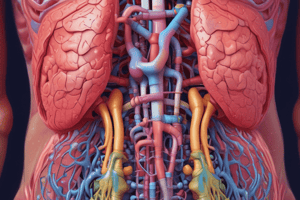Podcast
Questions and Answers
What term describes bowel sounds occurring after a long interval?
What term describes bowel sounds occurring after a long interval?
- Hypoactive bowel sounds (correct)
- Absent bowel sounds
- Normal bowel sounds
- Hyperactive bowel sounds
What are hyperactive bowel sounds also called?
What are hyperactive bowel sounds also called?
Borborygmi
Absent bowel sounds are identified if no sound is heard for 3 to 5 minutes.
Absent bowel sounds are identified if no sound is heard for 3 to 5 minutes.
True (A)
The landmarks for abdominal assessment include 4 quadrants, a horizontal line through the ______, and a vertical line through the xiphoid process and symphysis pubis.
The landmarks for abdominal assessment include 4 quadrants, a horizontal line through the ______, and a vertical line through the xiphoid process and symphysis pubis.
List the steps to abdominal assessment.
List the steps to abdominal assessment.
What type of bowel sounds are characterized by increased frequency and loudness?
What type of bowel sounds are characterized by increased frequency and loudness?
What structures are found in the upper right quadrant of the abdomen?
What structures are found in the upper right quadrant of the abdomen?
What structures are found in the left upper quadrant of the abdomen?
What structures are found in the left upper quadrant of the abdomen?
What structures are found in the lower right quadrant of the abdomen?
What structures are found in the lower right quadrant of the abdomen?
What structures are found in the lower left quadrant of the abdomen?
What structures are found in the lower left quadrant of the abdomen?
What sounds will you hear while auscultating the abdomen?
What sounds will you hear while auscultating the abdomen?
Flashcards
Hypoactive Bowel Sounds
Hypoactive Bowel Sounds
Sounds heard infrequently, with long intervals between them. This suggests decreased bowel activity.
Hyperactive Bowel Sounds
Hyperactive Bowel Sounds
Also known as borborygmi, these are frequent and loud sounds. They indicate increased bowel activity.
Absent Bowel Sounds
Absent Bowel Sounds
No bowel sounds are detectable over a 3-5 minute period, suggesting potential problems in the abdomen.
Abdominal Quadrants
Abdominal Quadrants
Signup and view all the flashcards
Abdominal Inspection
Abdominal Inspection
Signup and view all the flashcards
Abdominal Auscultation
Abdominal Auscultation
Signup and view all the flashcards
Abdominal Percussion
Abdominal Percussion
Signup and view all the flashcards
Abdominal Palpation
Abdominal Palpation
Signup and view all the flashcards
Upper Right Quadrant
Upper Right Quadrant
Signup and view all the flashcards
Upper Left Quadrant
Upper Left Quadrant
Signup and view all the flashcards
Auscultation Sounds
Auscultation Sounds
Signup and view all the flashcards
Study Notes
Bowel Sounds
- Hypoactive Bowel Sounds: Occur infrequently with sounds heard after long intervals; normal range is 5 to 34 sounds per minute.
- Hyperactive Bowel Sounds: Also known as borborygmi, characterized by frequent sounds indicative of increased intestinal activity.
- Absent Bowel Sounds: No sound detected over a 3 to 5-minute period suggests potential abdominal pathology.
Abdominal Assessment Landmarks
- Four quadrants created by intersecting horizontal line through the umbilicus and vertical line via xiphoid process and symphysis pubis serve as key landmarks.
Steps for Abdominal Assessment
- Inspection: Observe abdominal contour, skin, and movements from various angles (eye level, foot of the bed, directly above). Use lighting to highlight subtle changes.
- Assessment Terms: Contours may be flat, rounded, protuberant, or scaphoid; assess for signs of ascites (indicated by protuberance and firmness).
- Auscultation: Should precede palpation/percussion to avoid altering bowel motility. Normal sounds are irregular tinkling/gurgling every 5 to 20 seconds.
- Borborygmus: Reflects increased peristalsis; commonly noted before meals as "stomach growling," linked to factors like diarrhea or intestinal obstruction.
- Percussion: Helps locate non-palpable organs, identifies masses; tympanic sounds indicate air in intestines, dull sounds indicate solid organs like the spleen.
- Palpation: Conduct light palpation first to detect pain; deep palpation assesses any unusual masses or enlarged organs (e.g., liver). A relaxed abdomen is crucial for an accurate assessment.
Abdominal Quadrants
- Upper Right Quadrant: Contains liver, gallbladder, duodenum, head of pancreas, right adrenal gland, upper lobe of right kidney, ascending colon, and part of the transverse colon.
- Upper Left Quadrant: Includes left lobe of liver, majority of stomach, spleen, upper lobe of left kidney, pancreas, left adrenal gland, and segments of transverse and descending colon.
- Lower Right Quadrant: Houses the lower lobe of right kidney, cecum, appendix, ascending colon, right ovary, fallopian tube, ureter, spermatic cord, and possibly part of the uterus.
- Lower Left Quadrant: Consists of lower lobe of left kidney, sigmoid colon, descending colon, left ovary, fallopian tube, ureter, spermatic cord, and possibly part of the uterus if enlarged.
Auscultation Sounds
- Characterized by gurgling and swishing, indicating normal bowel activity and movement.
Studying That Suits You
Use AI to generate personalized quizzes and flashcards to suit your learning preferences.




